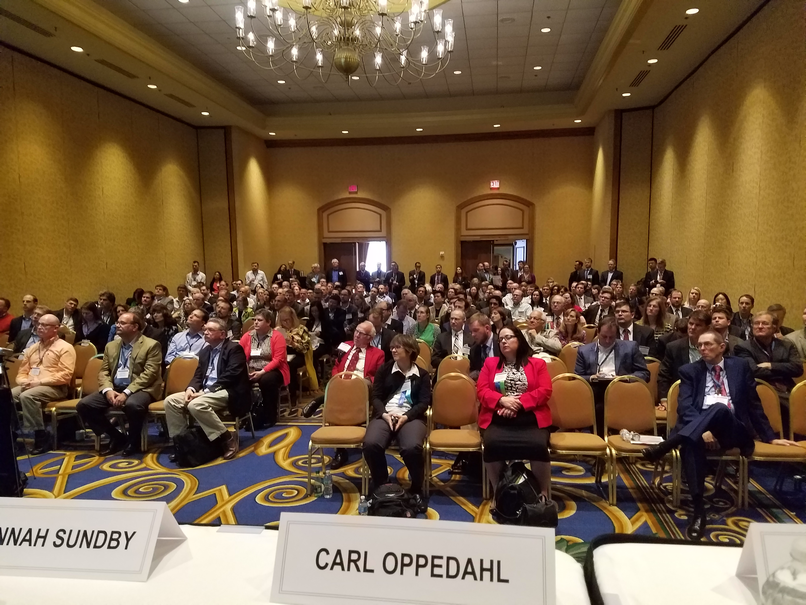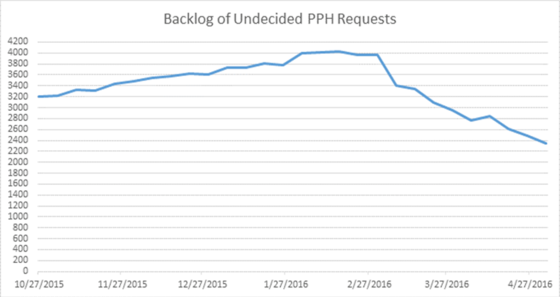 Today I gave a presentation on Restoration of Priority. This was at the AIPLA meeting in Minneapolis. Here was the audience. I guess about 150 people. Also on the dais were Robert Sachs, talking about Section 101 and Alice, and Suzannah Sundby, talking about Section 101 in the biotech/pharma world. You can download my slides here.
Today I gave a presentation on Restoration of Priority. This was at the AIPLA meeting in Minneapolis. Here was the audience. I guess about 150 people. Also on the dais were Robert Sachs, talking about Section 101 and Alice, and Suzannah Sundby, talking about Section 101 in the biotech/pharma world. You can download my slides here.
USPTO does better with PPH requests lately
Yesterday the USPTO published a graph showing progress in disposing of what had been a very discouraging backlog of unattended-to Patent Prosecution Highway requests. Here is the graph:
requests. Here is the graph:
From a glance at this graph, one might have the impression that the problem at the USPTO had started in October of 2015. In fact the problem dated from at least as early as November 2014, when I blogged about ever-increasing delays at the USPTO in granting PPH requests. In April of 2015 I had faxed a letter to Director Lee about this growing backlog.
USPTO’s graph indicates a backlog of unattended-to PPH requests of about 3200 cases in October 2015, reaching a peak of about 4000 in February 2016, and a notable drop to around 2400 as of a few weeks ago. (I note that our firm, all by itself, was responsible for something like 2% of all of these PPH cases.)
The interesting question is how this effort at the USPTO is working out nowadays for particular applicants. We try to track these things pretty closely at our firm, and here is what we see. Continue reading “USPTO does better with PPH requests lately”
Please attend the OPLF reception in Orlando
Will you be in Orlando, Florida at the time of the 2016 meeting of INTA (the International T rademark Association)? Are you a member of the E-Trademarks Listserv? Are you with a trademark or patent firm located outside of the US? Or are you with a corporation? If so, we hope you will join the people of Oppedahl Patent Law Firm LLC at our reception for the E-Trademarks Listserv. Our reception will take place at B B King’s Blues Club from 5PM to 8PM on Tuesday, May 24.
rademark Association)? Are you a member of the E-Trademarks Listserv? Are you with a trademark or patent firm located outside of the US? Or are you with a corporation? If so, we hope you will join the people of Oppedahl Patent Law Firm LLC at our reception for the E-Trademarks Listserv. Our reception will take place at B B King’s Blues Club from 5PM to 8PM on Tuesday, May 24.
To learn more abut the reception, and to RSVP, please click here.
Post-reg astonishingly fast all of a sudden
A few months ago, trademark practitioners were comparing experiences with backlogs at “post-reg”. By this we mean the branch of the USPTO that handles papers filed after a trademark has registered. (The forum in which they discussed these backlogs is the E-trademarks listserv.) As of a few months ago, they were seeing backlogs in the range of 2-3 months. But recently things seem to have improved drastically. Continue reading “Post-reg astonishingly fast all of a sudden”
Does someone own Klingon?
Does some person or entity own the Klingon language?
Continue reading “Does someone own Klingon?”
USPTO grants first-ever design patent from a Hague application
The USPTO has granted the first-ever US design patent from an international design (Hague) application.
The international design application was filed pro se on May 13, 2015 by a German company called Schwan-Stabilo Cosmetics GmbH & Co. KG. The application was filed directly at the International Bureau and it designated Korea and the US. It did not claim priority from any earlier application.
The IB published the application on June 5, 2015 and the USPTO received the application from the IB on that day. The USPTO gave application number 35/500,001 to the application.
The USPTO mailed a Filing Receipt on July 7, 2015. The case got assigned to an Examiner on October 6, 2015 and the Examiner allowed the case eleven days later. The USPTO sent the Notice of Allowance to the IB on October 20, 2015. The applicant paid the Issue Fee directly to the IB. The OB sent the Issue Fee to the USPTO on November 30, 2015.
USPTO issued the patent on April 26, 2016 as US Patent Number Des. 754922. You can see it here.
No Assignment has been recorded for this application. No IDS got filed in this application. The application was never touched by US patent counsel.
Long backlogs at Global Entry interview offices
(See update here.)
I guess I should not be surprised that the USPTO is not the only US government agency with long backlogs.
Someone I know recently applied for Global Entry — the very handy program that speeds up immigrations entry into the US and gets you into TSA’s Precheck security screening. He then received the “conditional approval” and an invitation letter to attend an interview at a Global Entry interview office.
That’s great! All he has to do now is make an appointment at one of the interview offices, and show up for the appointment, and he will be a member of Global Entry.
Except that interviews are not easy to get.
- At San Francisco airport, the earliest available appointment is October 23. Five months from now.
- At Portland (Oregon) airport, the earliest available appointment is September 26. Four months from now.
- At Denver airport, there is simply no appointment available no matter how long you are willing to wait.
This is quite a surprise to me. It seems to me that the Global Entry folks need to staff up the interview offices appropriately so that there are enough people to do the interviews without delays of four and five months (or forever in the case of Denver).
Docketing PPH – chief sources of delay
What are the Best Practices for docketing PPH? What are the chief sources of delay that the practitioner hopes to control or minimize as part of the PPH docketing process? In this article I will try to answer these two questions. Continue reading “Docketing PPH – chief sources of delay”
Yet another nice thing about ePCT
The other day I stumbled quite by chance upon yet another nice thing about ePCT. In this blog article I will describe the nice thing. And the alert reader might be able to win a prize. Continue reading “Yet another nice thing about ePCT”
Get some PCT CLE in Nashville on May 6
Yours truly will speak at the Spring CLE program of the Tennessee Intellectual Property Law Association, on Friday, May 6 in Nashville, Tennessee. You can see the brochure here. I will lecture on best practices for use of the Patent Cooperation Treaty. I look forward to seeing lots of Tennessee patent practitioners at this program.
